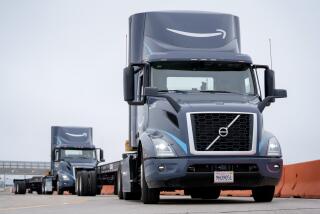Vote on Emissions Measure Is Delayed
- Share via
SACRAMENTO — California air quality officials put off a vote on the state’s hotly contested zero-emissions vehicle mandate, but strongly indicated last week that they don’t intend to scrap the measure, which would require automakers to produce smog-free cars.
The mandate was adopted 13 years ago, but last year the staff of the state Air Resources Board recommended freeing car makers from long-term commitments.
Major car makers have stopped making battery-powered cars, the only viable nonpolluting models available.
Meeting Thursday and Friday, board members sent a strong signal to automakers that they should expect a revised regulation that will require a mix of low-pollution and nonpolluting cars. The board is expected to vote on the issue at its April 24 meeting.
Board Chairman Alan C. Lloyd said the mandate would continue in a more flexible form.
“The mandate is alive and well. We’re all committed to cleaning up the air faster. We’re all committed to zero-emissions vehicles,” he said.
But after a 13-hour public hearing, the air board was deadlocked over exactly how to reshape the program over the next 11 years.
After examining various options, the board indicated it is leaning strongly toward a revised approach favoring clean-running hybrid cars, which are powered by dual gasoline and electric motors. Many are already in use, and hundreds of thousands more could be required to be in dealer showrooms by the end of the decade.
Also, the board made clear it intends to require manufacturers to build a fleet of cars powered by fuel cells, which use chemicals to make electricity and emit only water vapor as exhaust. The board indicated it wants to speed up the work that automakers are doing with that technology.
And, to the disappointment of car makers, some air board members want to include a significant role for battery-powered cars. A large and enthusiastic crowd of battery-car owners and entrepreneurs attended the meeting and seemed to sway the board to ensure that the cars are among the mix of new cars in the future.
“We’ve had a lot of experience with battery technology, and at this time, we do not believe it is commercially viable,” said Ben Knight, vice president of research and development for Honda.
Other cars in the mix include very low-polluting gasoline-powered models, cars that plug in and run on electric motors for limited distances, and compressed natural gas vehicles. Technological advances, some spurred by the 13-year-old California law, have led to a wide mix of clean machines.
“The board is looking for a path to zero emissions. The board says they want to continue to fight to get to zero. This is great for clean air that Californians will have the chance to buy a clean, advanced technology vehicle in the future, and there could be several choices available,” said Roland Hwang of the Natural Resources Defense Council.
Members of the air board were sharply divided over the quantity and types of low and no-emission cars to be required, as well as how soon the vehicles should arrive in showrooms and how rapidly to expand sales quotas. California is the nation’s leading market for new cars, with 1.8 million vehicles sold annually.
Revisions became necessary late last year after a lawsuit by DaimlerChrysler and General Motors that threatened to overturn key elements of the clean-car program. The program was established in 1990, but has had a rocky history, moving in fits and starts, and marred by disagreements between the auto industry and California regulators -- a trend the air board hopes to reverse when it overhauls the program next month.






